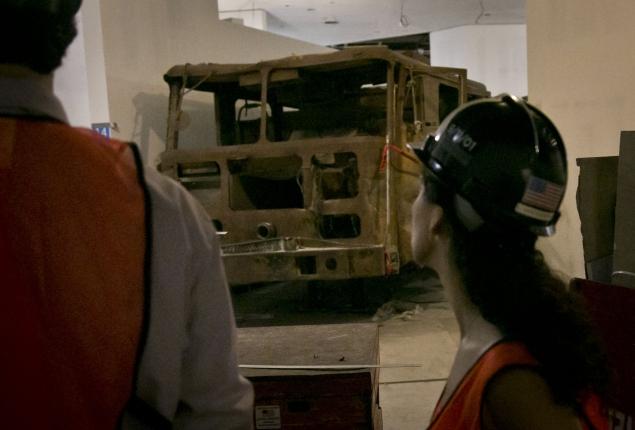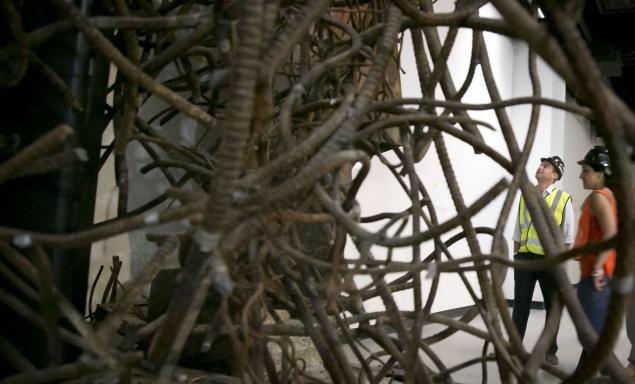
Anthoula Katsimatides, right, a member of the 911 Memorial board, views the wreckage of FDNY Engine 21 recovered from the World Trade Center site in New York. Her brother John Katsimatides was killed when planes struck the WTC towers September 11, 2001. Engine Company 21 was dispatched to the World Trade Center after hijacked Flight 175 struck the South Tower. It was parked beneath an elevated walkway when the towers fell. Bebeto Matthews/AP
NEW YORK — Gray dust blankets everything in the subterranean halls of the unfinished National September 11 Memorial & Museum. But while the powder may look ominously like the ash that covered lower Manhattan after the terrorist attacks, this time it is a product of rebirth, not destruction.
After a yearlong construction shutdown because of a funding dispute, and additional months of cleanup following a shocking flood caused by Superstorm Sandy, work has been racing ahead again at the museum, which sits in a cavernous space below the World Trade Center memorial plaza that opened in 2011.
About 130 workers are at the site each day and there is much left to be done, but officials with the museum said the project is on track to open to the public in the spring of 2014.
Some of the museum’s most emotion-inspiring artifacts already are anchored in place.
Tears rolled down Anthoula Katsimatides’ cheeks Thursday as she toured halls holding a mangled fire truck, strangely beautiful tangles of rebar and the pieces of intersecting steel known as the Ground Zero Cross.

Joe Daniels, left, 9/11 Memorial President, and Anthoula Katsimatides, right, a member of the 9/11 Memorial board, are seen through tangled steel recovered from the World Trade Center attacks. Bebeto Matthews/AP
“It makes me sad,” said Katsimatides, whose brother John died at the trade center. But it’s also inspiring, said Katsimatides, who sits on the museum’s board. “Seeing it come to fruition is pretty intense.”
Work on the museum was halted for nearly a year, starting in the fall of 2011, because of a money fight between the memorial foundation and the Port Authority of New York and New Jersey, which owns the trade center site.
In retrospect, that slowdown was a blessing. Shortly after the two sides worked out their differences, Superstorm Sandy sent the Hudson River thundering through lower Manhattan and filled the museum cavern with 7½ feet of water.
The flood destroyed interior walls and electrical circuits, but the construction delay meant that hundreds of artifacts and exhibits that might have been in the museum still hadn’t been fabricated or were sitting safely in storage. There was minor flash rusting to one of the fire trucks that had already been lowered into the space, but the damage was repaired by conservators and isn’t noticeable today, said National September 11 Memorial & Museum President Joseph Daniels.
Today there is no sign that there was ever a flood. Daniels said there has been “almost indescribable” progress on construction since the storm.
Structural work appears mostly complete on the glass pavilion and wide staircase and ramp visitors will use to descend into the museum, past two towering “tridents” that once helped form the distinctive base of the twin towers. Once silvery, the columns were stripped bare by the fires on 9/11 and are now the color of rusted, raw steel.
From a mezzanine, patrons will be able to peer into a deep, nave-like hallway nicknamed the South Canyon. The hall’s high western wall will eventually be covered with artwork that people around the world made in tribute to the victims after the attacks. Another exhibit will feature supportive notes and letters.
“They continue to send things. It’s amazing,” Katsimatides said. “That outpouring of support is one of the things that got the 9/11 families through.”
Further down the ramp, visitors come to a platform overlooking an even more massive cavern bordered by the slurry wall, a 70-foot-tall, steel-studded concrete slab originally built to keep the Hudson River from flooding the trade center construction site.
In the hall’s center stands the last steel column removed from ground zero during the cleanup operation. Recovery workers covered the pillar with their signatures before it was carried away, and visitors will get a chance to leave their own mark on another big piece of steel near the museum’s exit — though their autographs will be captured by a computerized touch screen and projected on the slurry wall, rather than left in ink on metal.
Throughout the museum, curators have hung pieces of steel that were bent and twisted into striking shapes, including one sheet of metal that now appears to ripple like a flag and a huge girder bent by the impact of the aircraft hitting the towers.
Many of them look like sculptures.
“In a strange way, they are like pieces of art,” Katsimatides said. But Daniels added that they weren’t chosen for their beauty, but to explain what happened at the site on 9/11.
A few design elements of the museum are still under discussion.
When visitors descend to the very bottom of the museum — where, in some places, they will be able to view the very bedrock that the towers once rested upon — they will enter a hall with a large wall bearing an inscription from Virgil. “No day shall erase you from the memory of time.”
Behind that wall will sit a special mausoleum, off limits to the general public, containing the unidentified remains of hundreds of 9/11 victims. Most of the interior walls of the museum have the look of bare concrete, as a constant reminder of the site’s location within the old trade center foundation. But Daniels said the museum’s designers are talking about possibly cladding this wall in a different material, or a different color, to separate it from the rest.
“It’s a special place. Do we need something to distinguish it?” he said.
The bulk of the work remaining to be completed will revolve around installing the museum’s exhibits, which will include many artifacts, including a wall made up of portraits of all 2,983 victims and a room where visitors will be able to call up video presentations that tell a story about each of them.
“The idea is to learn about the lives that they lived, not just the deaths that they died,” Daniels said.

